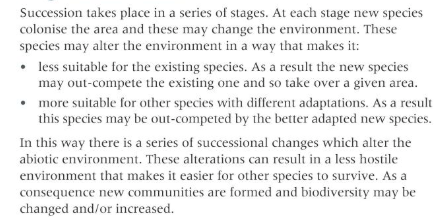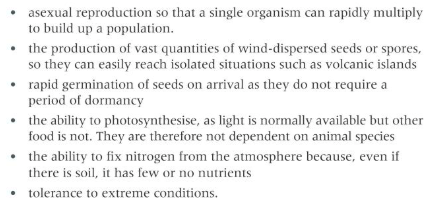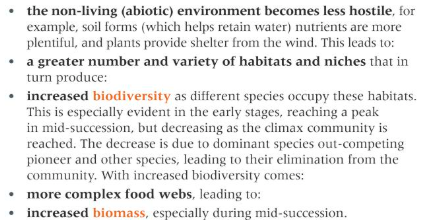19.6 Succession
1/12
There's no tags or description
Looks like no tags are added yet.
Name | Mastery | Learn | Test | Matching | Spaced |
|---|
No study sessions yet.
13 Terms
Succession:
Succession is a term that is used to describe changes which happen over time in the species that occupt a particular area. It's essentially the gradual replacement of one community by another, leading to a more complex and stable ecosystem.
Stages of succession:

First stage of this type of succession is:

Pioneer species make up a pioneer community and often have features that suit them to colonisation: These may include -

During succession there are a number of common features that emerge:

What is succession?
A term to describe the changes in an ecosystem that occur over time in the species that occupy a particular area
Pioneer species
• These make up the pioneer community
• They are able to tolerate hostile abiotic conditions
• Other common features include.
• Asexual, wind-dispersal of seeds or spores, rapid germination
• Photosynthetic, nitrogen-fixing
• Tolerant of extreme conditions
Early colonisers
• These very simple plants are able to take advantage of the improved
abiotic conditions provided by the shallow soil.
• Mosses are able to increase in size and as they erode the rock and die
to produce a greater soil volume, more water can be held and more
nutrients become available. These allow larger plants like ferns to
grow
Features of a climax community
Same species present over a long time
Abiotic factors are constant/ stable
- Populations stable (around carrying capacity)
Competition
• As more plants area able to thrive in the less hostile conditions,
earlier plants are unable to compete effectively for resources and are
likely to fall in number or disappear completely.
• In a succession, earlier species are replaced by more successful
competitiors once the abiotic conditions are improved.
• This causes the changes in the species found in the ecosystem.
Animals
• Once there are plants growing the animals will come
• Dead lichen provide food for detritus feeding mites
• Mosses & grasses provide food & habitats for insects, millipedes and
worms
• These will then allow predators such as centipedes to feed
• Trees attract many larger organisms, including reptiles, mammals &
birds.
Things that effect succession
Early colonisers outcompete the pioneers since they are better adapted for the new conditions. Each successive plant outcompetes the previous one.
Land mass, weather
During a succession
• Abiotic environment becomes less hostile
• Increase in number & variety of habitat & niche
• Increase in biodiversity...peak mid succession
• More complex food webs
• Increase in biomass...peak mid succession